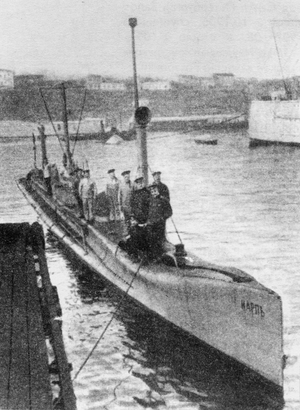Karp-class submarine
 Russian submarine Karp | |
| Class overview | |
|---|---|
| Name: | Karp class |
| Builders: | Germaniawerft |
| Operators: | |
| In commission: | 1907–1919 |
| Completed: | 3 |
| Lost: | 3 |
| General characteristics | |
| Type: | Submarine |
| Displacement: |
|
| Length: | 39.6 m (129 ft 11 in) |
| Beam: | 2.7 m (8 ft 10 in) |
| Draught: | 2.5 m (8 ft 2 in) |
| Propulsion: |
|
| Speed: |
|
| Range: | 1,250 nmi (2,320 km) |
| Test depth: | 96 ft (29 m) |
| Complement: | 28 |
| Armament: |
|
The Karp class were a class of submarines built by Krupp Germaniawerft for the Imperial Russian Navy. The class, composed of three boats (Karp, Kambala, Karas) were ordered in the 1904 emergency programme as a result of the Russo-Japanese War. The design was a twin hull type powered by a kerosene-electric power plant with a 16-fathom (96 ft; 29 m) diving limit. The boats were delivered late for the war and transferred to the Black Sea Fleet by rail in 1908. In 1909, Kambala was lost. The other two submarines remained in service until their withdrawal in March 1917. They were taken over in April 1918 by the Ukrainian State before being captured by the German Empire in May and transferred to the British following the German surrender in November. The British scuttled Karp and Karas in 1919 to prevent their capture by the Soviets.
Description
The Karp class was of a twin-hulled design produced by Raimondo Lorenzo D’Equevilley-Montjustin that had a surface displacement of 210 tonnes (207 long tons) and were 239 t (235 long tons) submerged. They were 39.6 metres (129 ft 11 in) long overall with a beam of 2.7 metres (8 ft 10 in) and a draught of 2.5 metres (8 ft 2 in). The submarines were powered by a kerosene-electric power plant driving two shafts. The two kerosene-powered engines were rated at 298 kilowatts (400 bhp) and the two electric motors, 149 kilowatts (200 hp). Kerosene was chosen over gasoline as the fuel choice due to its better safety record. The submarines had a maximum speed of 10 knots (19 km/h; 12 mph) on the surface and 8.5 knots (15.7 km/h; 9.8 mph) submerged. They had a range of 1,250 nautical miles (2,320 km; 1,440 mi) on the surface and 50 nautical miles (93 km; 58 mi) submerged. They were armed with one 457-millimetre (18.0 in) torpedo tube and two external Drzewiecki drop collars for torpedoes. They had a complement of 28 officers and ratings.[1][2] The submarines had seven ballast and trimming tanks, and could dive to 16 fathoms (96 ft; 29 m).[1] The design served as the prototype for the first German U-boat, U-1, which was commissioned into the Imperial German Navy on 14 December 1906.[3] U-1 has been preserved, and is currently on display at the Deutsches Museum in Munich.[4]
Boats in class
| Karp-class submarines[1] | |||
| Name | Builder | Launched | Fate |
|---|---|---|---|
| Karp (Карп) | Germaniawerft, Kiel | 1907 | Scuttled at Sevastopol on 26 April 1919. |
| Kambala (Камбала) | 1907 | Sunk in collision with the battleship Rostislav, 11 June 1909. | |
| Karas (Карась) | 1907 | Decommissioned in 1917. Scuttled at Sevastopol on 26 April 1919. | |
Service history
Three submarines were ordered as part of the 1904 emergency building programme as part of the naval buildup of the Russo-Japanese War. A German design build and constructed in the German Empire, the Karp class was only delivered to Russia in 1907. The submarines were transferred by rail to the Black Sea in 1908 and joined the Black Sea Fleet.[1] Kambala sank in 1909. The reason and location of this sinking is unclear. Some reports have the submarine sinking near Kronstadt due to an erroneously opened valve while others have her sinking in an accidental collision with the Russian battleship Rostislav near Sevastopol on 11 June.[1][5] It has even been suggested that she sank twice first near Kronstadt then after being salvaged was sunk again near Sevastopol.[5] Parts of the wreck were raised later in 1909 and broken up for scrap.[1]
Karp and Kambala remained in service throughout World War I until March 1917 when they were withdrawn from service and hulked at Sevastopol. In April 1918, they were briefly taken over by the Ukrainian State before being captured by the German Empire in May. With the German surrender in November 1918, the submarines were turned over to the British. The submarines remained at Sevastopol during the Russian Civil War until 26 April 1919, when they were scuttled to prevent their capture by the Soviets.[1]
Citations
- 1 2 3 4 5 6 7 Gardiner & Gray 1986, p. 313.
- ↑ Watts 1990, p. 163.
- ↑ Showell 2006, p. 30.
- ↑ Showell 2006, p. 36.
- 1 2 Gray 2003, pp. 61–62.
Sources
- Gardiner, Robert & Gray, Randal, eds. (1986). Conway's All the World's Fighting Ships 1906–1921. London: Conway Maritime Press. ISBN 0-85177-245-5.
- Gray, Edwyn (2003). Disasters of the Deep A Comprehensive Survey of Submarine Accidents & Disasters. Barnsley, UK: Leo Cooper. ISBN 0-85052-987-5.
- Showell, Jak (2006). The U-Boat Century; German Submarine Warfare 1906-2006. Great Britain: Chatham Publishing. ISBN 1-86176-241-0.
- Watts, Anthony J. (1990). The Imperial Russian Navy. London: Arms and Armour Press. ISBN 0-85368-912-1.